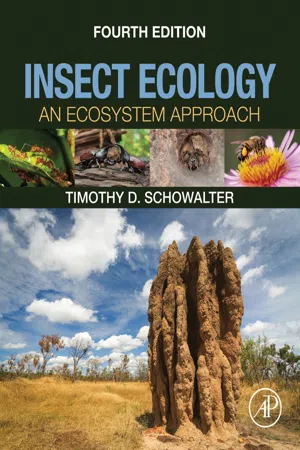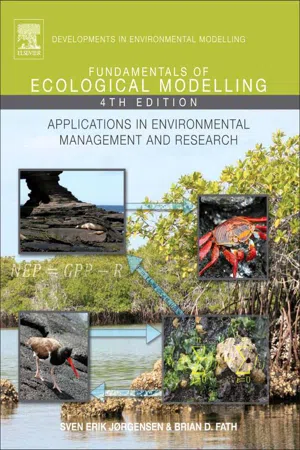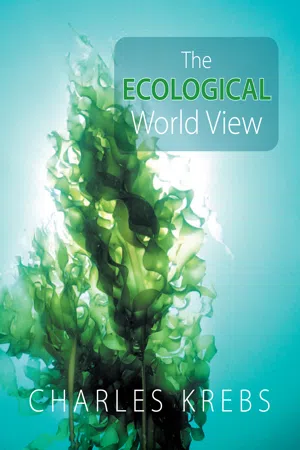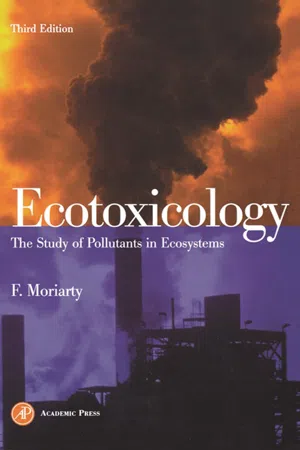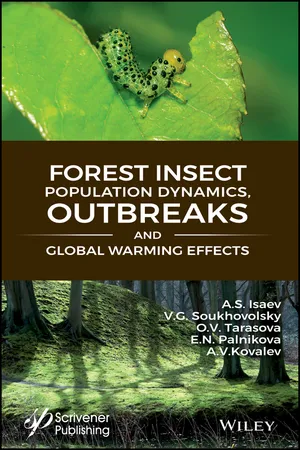Biological Sciences
Population Dynamics
Population dynamics refers to the study of how populations of organisms change over time. It involves examining factors such as birth rates, death rates, immigration, and emigration to understand population growth or decline. This field also explores the interactions between different species within a community and the impact of environmental factors on population size and distribution.
Written by Perlego with AI-assistance
Related key terms
7 Key excerpts on "Population Dynamics"
- eBook - ePub
Insect Ecology
An Ecosystem Approach
- Timothy D. Schowalter(Author)
- 2016(Publication Date)
- Academic Press(Publisher)
Section II Population ecologyIntroduction Chapter 5: Population Systems Chapter 6: Population Dynamics Chapter 7: BiogeographyPassage contains an image
Introduction
A population is a group of interbreeding members of a species and represents a fundamental unit of evolution and ecology. Individual fitnesses are integrated at the population level to determine species abundance and persistence or extinction. This is the level of ecological organization that is the focus of evolutionary ecology, ecological genetics, biogeography, sampling methodology, pest management, and recovery of endangered species. These disciplines all have contributed enormously to our understanding of population-level phenomena.A number of more or less discrete subpopulations may be distributed over the geographic range of a species population. Movement of individuals among these demes (composing a metapopulation ) and newly available resources compensates for local extinctions resulting from disturbances or biotic interactions (Hanski and Gilpin, 1997 ). Populations are characterized by structural attributes, such as density, dispersion pattern, and age, sex, and genetic composition (Chapter 5 ) that change through time (Chapter 6 ) and space (Chapter 7 ) as a result of responses to changing environmental conditions.Population structure and dynamics of insects have been the subject of much ecological research. Examination of population structure and process rates can provide clues to invasiveness or conservation status in changing habitats. Population structure also can indicate future population trends. Predicting outbreaks requires understanding of relationships between population structure and changes in population size. Rapidly growing populations typically are characterized by a high production of offspring per adult. Some growing populations also show changes in geographic distribution of individuals. - eBook - ePub
- Harkaran Singh, Joydip Dhar(Authors)
- 2018(Publication Date)
- Apple Academic Press(Publisher)
Chapter 1Introduction and Mathematical Preliminaries
1.1 IntroductionMathematical biology, nowadays, is a well-known field, which is growing fast, being an interdisciplinary subject and undoubtedly, has been one of the most appealing applications of mathematics. The complexity of the biological sciences makes the interdisciplinary involvement essential. For the mathematicians, biology opens up numerous new branches, while, for the biologists, mathematical modeling offers another powerful research tool. Further, population biology and epidemiology is a fascinating domain of study in the field of biomathematics for today’s researchers. The increasing study of realistic and practically useful mathematical models in Population Dynamics and epidemics is a reflection of their use in helping to understand the dynamic processes involved therein and in making practical predictions [1 ].1.1.1 Population DynamicsA population is a group of individuals who live together in the same habitat and are likely to interbreed. It may contain individuals of different ages, and the age of an individual is likely to change over time.Further, the size of a population may grow or shrink depending on the biological and environmental parameters such as birth rates, death rates, immigration, and emigration. The study on these changes of age and size of a population is known as Population Dynamics. Some of the examples are population growth, population decline, and aging population. Also, for interpreting survey data and predicting pest outbreaks, a good under- standing of Population Dynamics is very much useful [2 –4 ].1.1.2 Prey-Predator InteractionsThe Population Dynamics of each species is affected when two or more species interact. There are three types of interactions among the species: (i) if the growth rate of one species is increasing and the others is decreasing, then they are in a prey-predator relationship; (ii) if the growth rate of each species is decreasing, then they are competing; and (iii) if the growth rate of each species is increasing, then they are in mutualism [5 ]. It is a well-known fact that the prey-predator interactions is a subject of great interest in the bio-mathematical literature starting with the pioneer work of Lotka [6 ] and Volterra [7 ], and the dynamic relationship between predator and prey living in the same environment will continue to be one of the important themes in mathematical ecology [8 , 9 ]. A number of mathematicians, in the past, have studied prey-predator models and contributed to their development and even today’s mathematicians are engaged in anticipating and understanding the diverse biological world of prey-predator systems [10 –18 - eBook - ePub
- Laurie Ann Callihan(Author)
- 2013(Publication Date)
- Research & Education Association(Publisher)
CHAPTER 7 Population Biology CHAPTER 7 POPULATION BIOLOGY ECOLOGYEcology is the study of how organisms interact with other organisms and how they influence or are influenced by their physical environment . The word “ecology” is derived from the Greek term oikos (meaning “home” or “place to live”) and ology (meaning “the study of ”), so ecology is a study of organisms in their home. This study has revealed a number of patterns and principles that help us understand how organisms relate to their environment. First, however, it is important to grasp some basic vocabulary used in ecology.The study of ecology centers on the ecosystem. An ecosystem is a group of populations found within a given locality, including the abiotic environment around those populations. A population is the total number of a single species of organism found in a given ecosystem. Typically, there are many populations of different species within a particular ecosystem. The term organism refers to an individual of a particular species. Each species is a distinct group of individuals that are able to interbreed (mate), producing viable offspring. Although species are defined by their ability to reproduce, they are usually described by their morphology (their anatomical features).Populations that interact with each other in a particular ecosystem are collectively termed a community . For instance, a temperate forest community includes pine trees, oaks, shrubs, lichen, mosses, ferns, squirrels, deer, insects, owls, bacteria, fungi, etc.The part of the Earth that includes all living things is called the biosphere . The biosphere also includes the atmosphere (air), the lithosphere (ground), and the hydrosphere (water).A habitat refers to the physical place where a species lives. A species’ habitat must include all the factors that will support its life and reproduction. These factors may be biotic (i.e., living—food source, predators, etc.) and abiotic - eBook - ePub
Fundamentals of Ecological Modelling
Applications in Environmental Management and Research
- S.E. Jorgensen(Author)
- 2011(Publication Date)
- Elsevier(Publisher)
5 Modelling Population Dynamics5.1. Introduction
This chapter covers population dynamic models where state variables are the number or biomass of individuals or species. The growth of one population is used — see Sections 5.2 and 5.3 — to present the basic concepts. Afterward, the interactions between two or more populations are presented. The famous Lotka-Volterra model and several more realistic predator-prey and parasitism models, are shown. Age distribution is introduced and computations with matrix models are illustrated, including the relations to biological growth. Finally, the last three sections illustrate the use of fishery/harvest models, metaPopulation Dynamics, and infection models.5.2. Basic Concepts
This chapter deals with biodemographic models, which are population models characterized by numbers of individuals or kilograms of biomass of individuals or species as typical units for state variables. As early as the 1920s, Lotka and Volterra developed the first population model, which is still widely used (Lotka, 1956 ; Volterra, 1926 ). So many population models have been developed, tested, and analyzed since that it would not be possible to give a comprehensive review of these models here. This chapter mainly focuses on models of age distribution, growth, and species interactions. Only deterministic models will be mentioned. Those interested in stochastic models can refer to Pielou (1966 , 1977 ), which gives a very comprehensive treatment of this type of population dynamic model.A population is defined as a collective group of organisms of the same species. Each population has several characteristic properties, such as population density (population size relative to available space), natality (birth rate), mortality (death rate), age distribution, dispersion, growth forms, and so forth.A population changes over time, and we are interested in its size and dynamics as it grows or shrinks. If N represents the number of organisms and t the time, then dN/dt = the rate of change in the number of organisms per unit time at a particular instant (t), and dN/(Ndt) = the rate of change in the number of organisms per unit time per individual at a particular instant (t). If the population is plotted against time, then a straight line tangential to the curve at any point represents the growth rate. - eBook - ePub
- Charles Krebs(Author)
- 2008(Publication Date)
- CSIRO PUBLISHING(Publisher)
Populations are dynamic. They grow and decline, and one important goal of ecology is to understand why. Growing populations are highly desirable if they are crop plants or fish that we want to harvest, but they can also be undesirable if they are pest species or disease organisms such as the anthrax bacterium. Population Dynamics is a quantitative subject—it requires us to calculate the rate at which populations change. But we can use graphs to illustrate the principles of population change without delving into the underlying mathematics. Let us start our analysis with a simple model of how a population might increase over time. We will then look at patterns of population change over time in nature.Geometric Population Growth
Imagine a population that has been released into a favorable environment and begins to increase in numbers. What forms will this increase take, and how can we describe it quantitatively? To begin, let us consider the simple case in which generations are separate, as in annual plants, which have a single breeding season and a lifespan of one year. What happens to this population will depend on the number of female offspring that survive and reproduce the following year (see Essay 6.1 ). The pattern of population change is called geometric population growth (or exponential growth) because, in the simplest case, the population grows like the geometric series 1, 2, 4, 8, 16, 32, 64, and so on.Figure 6.1 shows some examples of geometric population growth in which different numbers of female offspring are produced in each generation. As you would expect, the more female offspring that are produced, the more rapidly the population increases. This is exactly the way money grows in a bank account with a constant annual rate of interest.However, populations do not continue to grow geometrically as in Figure 6.1. If they did, the world would be stacked high with elephants and oak trees. Aristotle pointed this out 2,300 years ago, and Darwin repeated it 150 years ago. Therefore, we must modify the geometric model to take into account the fact that all populations eventually stop growing.Figure 6.1. Geometric population growth in a hypothetical species of annual plant that has a constant reproductive rate. The four curves show how the growth rate depends on the average number of female offspring produced per generation (1.05, 1.10, 1.15 and 1.20). Each population begins with 10 females at generation 0. - eBook - ePub
Ecotoxicology
The Study of Pollutants in Ecosystems
- Frank Moriarty(Author)
- 1999(Publication Date)
- Academic Press(Publisher)
2Population Dynamics
No population remains constant in number for ever. This should be a self-evident statement, but it tends sometimes to be neglected when the ecological impact of pollutants is considered. This chapter is about one consequence of this statement: the effect that pollutants exert on population size is influenced greatly by many other factors. The introduction, or increase in amount, of a pollutant may coincide with the decrease in population size of one or more species, but this does not by itself indicate that the pollutant has necessarily affected that species. Nor does the certain proof that a pollutant has killed some individuals necessarily indicate that the population has been affected. Conversely, a pollutant that kills no individuals but has sublethal effects on a significant proportion of individuals could have a severe impact on the population.Although many factors can affect population size, their combined total impact can be determined by four measures: birth rates, death rates, gains from immigration and losses from emigration. The rates of these four processes must determine the subsequent size of any population. Pollutants are simply one factor amongst many that can influence one or more of these measures, and before we can understand the ecological effects of pollutants, we need to consider the nature of the fluctuations in population sizes—Population Dynamics.It will help if first we discuss briefly the “carrying capacity” of any particular habitat for any of the populations that occur within it. Every organism needs certain things from its environment: food, shelter, light, a restricted range of salinities for aquatic organisms—a very long list of possible needs can be made, but the essential point is that there is a limit to the amounts of these resources that any habitat can provide. The carrying capacity can then be defined as the maximum number of a species that a habitat can support throughout the complete life cycle. - A. S. Isaev, Vladislav G. Soukhovolsky, O. V. Tarasova, E. N. Palnikova, A. V. Kovalev(Authors)
- 2017(Publication Date)
- Wiley-Scrivener(Publisher)
Another approach is to develop models of intra-population interactions of insects and the influence of food and natural enemies on their density. These models are based on different types of differential equations, and analysis of these equations reveals different types of Population Dynamics. The choice of functions describing these interactions, however, may be quite arbitrary, as the models do not restrict this choice. Moreover, these models usually assume that model parameters are time invariant. If this assumption is invalidated, analysis of the models becomes very difficult.A third approach to analysis of phytophagous insect Population Dynamics is based on using phase portraits and identifying characteristic parameters that reflect interactions in a forest ecosystem (Isaev, Khlebopros, 1973; Isaev et al., 1984; Isaev et al., 2001; Isaev et al., 2009). By employing this approach, one can study not only different forms of population density regulation but also regulatory mechanisms of the entire ecological system, its stability and delays, positive and negative feedbacks, the ranges of the parameter values for certain effects, dimensions of the phase portraits and their qualitative content. Furthermore, there is no need to evaluate parameters of the forest ecosystem as influenced by specific environmental factors.Specific interactions between plants and insects in the forest ecosystem are manifested as a combination of continuous and discrete processes. Insect Population Dynamics is characterized by synchronous generations and discrete vital processes. As the insect life cycle is “short” (one or two years) relative to the “long” process of the ecosystem change (decades and centuries), insect Population Dynamics can be studied in terms of continuous systems.The simplest models used for analysis are regression models, in which Population Dynamics is described by some function of time F(t) of a certain linear or nonlinear form, and coefficients of this function are calculated by using methods of regression analysis (Biging et al., 1980; Campbell, Sloan, 1978a,b). If F(t
Learn about this page
Index pages curate the most relevant extracts from our library of academic textbooks. They’ve been created using an in-house natural language model (NLM), each adding context and meaning to key research topics.
